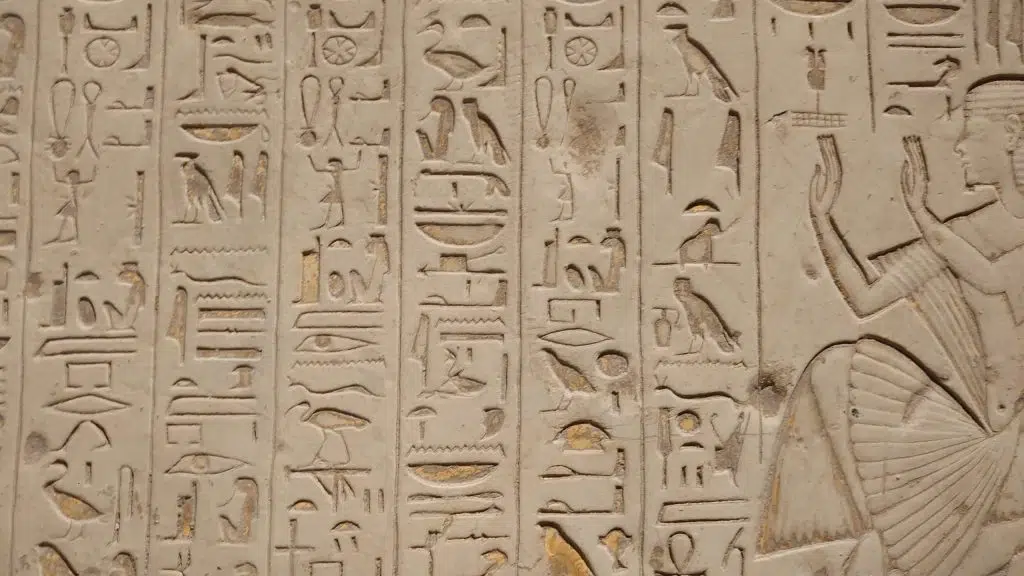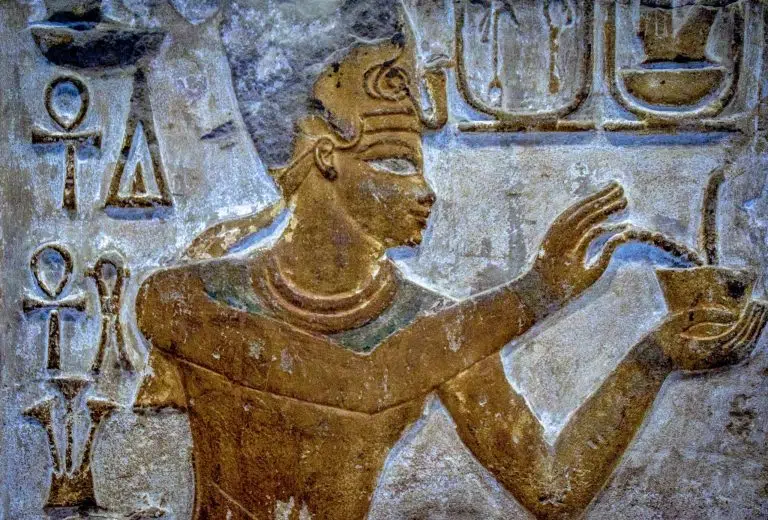Table of Contents
Period: 3100 BCE – 30 BCE
Characteristics: Art focused on afterlife, egyptian perspective
Events: Egypt is united (3100 BCE), War with the Hittites (1274 BCE), Cleopatra dies (30 BCE)
Introduction
This blog post will explore the fascinating world of ancient Egyptian art. From monumental sculptures and grand temples to intricate jewellery and painted murals, Egyptian art has captivated people for centuries and continues to do so even today. The art of ancient Egypt is characterised by a consistent and iconic style that portrays religion, pharaohs, and the afterlife. So, join me on this journey as we uncover the secrets of hieroglyphs, pyramids, and everything in between.
In last week’s Mesopotamia post, we saw how the first civilisations evolved from nomadic tribes. We also saw how art became more integral to society, progressing at both symbolic and practical levels. The differences between Mesopotamian and Egyptian styles are particularly notable. While Mesopotamian art focused on portraying powerful rulers and their military conquests, Ancient Egyptian art was characterised by a consistent and iconic style that depicted religion, pharaohs, and the afterlife.
One of the defining features of Egyptian art was its emphasis on creating a sense of timelessness. They achieved this by using a consistent and formulaic style recognisable across different mediums, such as monumental sculptures, grand temples, intricate jewellery, and painted murals. Strict adherence to specific rules and conventions, such as profile views and hieroglyphic writing, characterised this style. In contrast, Mesopotamian art was more varied and often featured scenes of war, hunting, and everyday life.

Ancient Egyptian Art
Art played a significant role in the lives of the Ancient Egyptians. It served as a medium of communication with their gods, honoured the dead, and celebrated the accomplishments of pharaohs and other influential figures. The importance of the afterlife and spiritualism is evident in the evolution of their art. Just as they preserved their dead through mummification, they tried to preserve art. That made the changes slow. This is one of the reasons why Ancient Egyptian art is often called the art of the dead.
Art and the Kingdoms of Egypt
Ancient Egypt is often divided into three major periods: the Old Kingdom (2700–2200 BCE), the Middle Kingdom (2040–1782 BCE), and the New Kingdom (1570–1544 BCE). Each period is characterised by significant political, social, and cultural changes, as well as artistic styles and themes.
Architects, sculptors, and painters frequently collaborated to produce beautiful and useful works of art in Ancient Egypt. One example is the pyramids built during the Old Kingdom period as tombs for pharaohs and their consorts. These massive structures were built by thousands of labourers to preserve the pharaoh’s body and ensure their safe passage to the afterlife. Similarly, large-scale statues of pharaohs were sculpted during this period to showcase their power and authority to their citizens.
In the Middle Kingdom period, Egyptian art turned more naturalistic and realistic. It emphasised the depiction of human figures in greater detail and precision. This led to a more natural style of portraiture becoming popular, with settings reflecting ordinary life and occupations being especially popular.
During the New Kingdom period, there was a resurgence of monumental architecture and sculpture, with the construction of awe-inspiring temples and other large-scale structures. Iconic works of Egyptian art were created during this period, such as the bust of Nefertiti and the mask of Tutankhamun, which continue to inspire admiration and wonder to this day.

Defining Aspects of Ancient Egyptian Art
Ancient Egyptian art served as a significant aspect of the country’s culture. It conveyed important religious and political messages while beautifying walls and architectural features. The hieroglyphs used for their writing system were integral to their art. They incorporated hieroglyphs into their works, creating aesthetically pleasing and informative pieces while conveying significant messages.
Egyptian art emphasised symmetry and balance. It reflected the Ancient Egyptian concept of ma’at, representing the cosmic order and balance of the universe. They did not use the modern concept of perspective in art. Instead, they employed a composite perspective technique to convey depth and spatial relationships within their artwork. This technique allowed them to showcase important cultural and religious messages. They depicted the most important figures or objects in the largest size and the least important figures or objects in smaller sizes.
One of the defining features of Ancient Egyptian art was its religious significance. It was used to communicate with the gods, honour the dead, and celebrate the pharaohs and other influential figures. The Egyptians believed that art had the power to transcend the boundaries between the physical and spiritual worlds, allowing them to connect with the divine and ensure a prosperous afterlife.
In addition to its religious significance, Ancient Egyptian art had utilitarian value. Architects, sculptors, and painters frequently collaborated to produce functional works of art, such as tombs, temples, and other large-scale structures. These works were aesthetically pleasing and served practical purposes, such as preserving the pharaoh’s body or providing a space for religious rituals.
Examples of Egyptian Art
With its lion’s body and a human’s head, the Great Sphinx of Giza is a well-known representation of ancient Egyptian art. It was constructed during the Old Kingdom under the reign of Pharaoh Khafre. The Sphinx measures 73 meters in length and 20 meters in height. It is thought to have been a protective figure for the nearby pyramids and temples and reflected the pharaoh’s divine status and power. Despite the mysteries surrounding its significance and meaning, the Sphinx is a remarkable example of the Egyptians’ artistic and engineering skills, demonstrating their mastery of sculptural art.
Another example is the Great Pyramid of Giza. It exemplifies ancient Egypt’s architectural and engineering expertise. The pyramid was erected during the time of Pharaoh Khufu and stands 139 meters tall. It consists of over 2 million limestone stones meticulously pieced together. As a symbol of power and monumental achievement, the pyramid served as a royal mausoleum for Pharaoh Khufu, reflecting his divine status and desire for eternal life. The pyramid has perfectly aligned sides and intricate internal chambers and corridors, which showcases the precision and planning that went into it.
In 1922, archaeologist Howard Carter discovered King Tutankhamun’s gold death mask. It can be argued that the mask is one of the most iconic masterpieces and a testimony to the artists of ancient Egyptians. The mask depicts the young pharaoh’s likeness with great detail. It also has a headdress and a ceremonial beard, symbolising divine kingship and eternal existence. The engravings and inlaid gemstones on the mask portray Egyptian mythological symbols and motifs, reflecting the rich culture of the New Kingdom era. This discovery was pivotal in archaeology, revealing insights into King Tutankhamun’s life and culture.



Conclusion
Ancient Egyptian art was diverse and reflected the society’s complexity. Symbolism and allegory were distinctive features, with the ankh and the scarab representing concepts like eternal life and rebirth. Despite changes, themes like symmetry, balance, and composite perspective endured, making the art look eternal. Art was integral to their culture and identity, serving as a means of communication, celebration, and remembrance. The skill and creativity of Ancient Egyptian artists continue to inspire admiration and wonder today. Its legacy encourages new generations of archaeologists and artists generation after generation.




